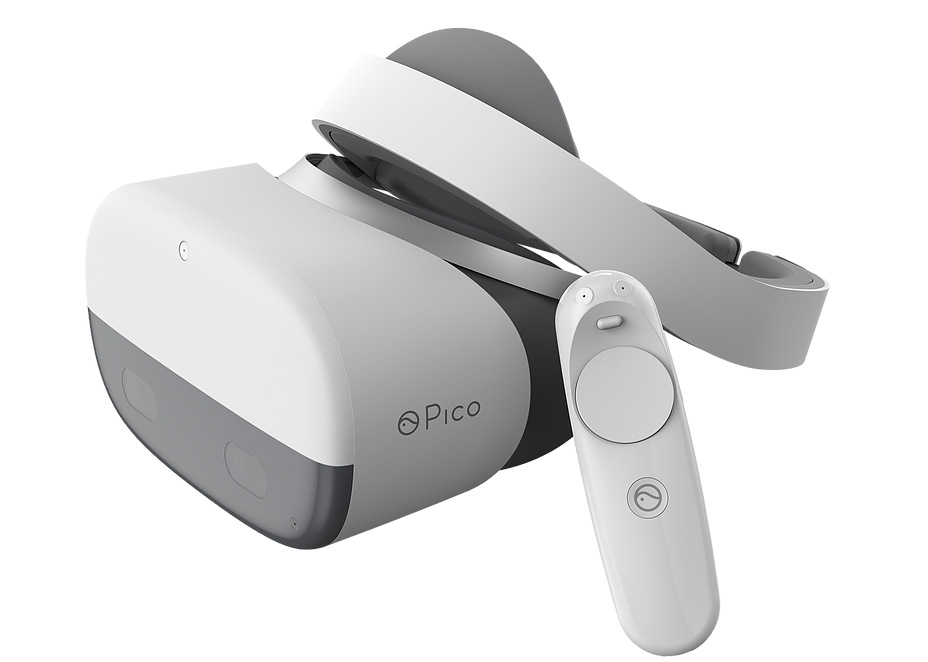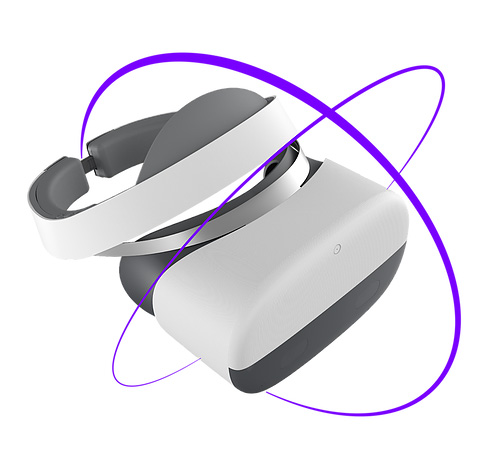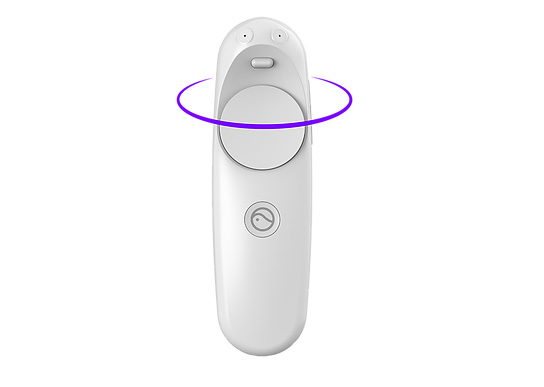The Pico Neo CV Headset Features Inside-Out Tracking, 6DoF Motion Controllers
Pico Technology is gearing up to disrupt the VR industry with the first self-contained, 6-degree of freedom (6DoF) VR headset with 6DoF motion controllers. The Pico Neo CV offers a room-scale VR experience without external cameras or a tethered host computer.
In early January, at CES 2017, Pico Technology revealed the Pico Neo CV and said that the hardware would hit the market within the year. Pico didn’t live up to its 2017 release plans, but that could be because the company went back to the drawing board after CES and redesigned the headset, the controllers, and the tracking technology.
The Neo CV headset the Pico showed off at CES featured two 90Hz “1.5K displays,” integrated speakers with AM3D 3D spatial audio technology, and internal gyro and rotational sensors. The headset relied on an optional external camera system to provide spatial tracking. The previous Neo CV design also included a Qualcomm Snapdragon 820 SoC, which seemed somewhat underpowered for a self-contained headset, especially after Qualcomm revealed the Snapdragon 835 SoC at the same show. Pico said that it took advantage of Qualcomm’s Snapdragon VR SDK to maximize the performance, but we still wondered if the Snapdragon 820 would be powerful enough for compelling VR at high resolution.
Evidently, Pico had reservations about its previous hardware design and went back to the drawing board. The new Pico Neo CV headset features Qualcomm’s higher-end SoC, which should handle the rendering workload more effectively than the older Snapdragon 820. Using the Snapdragon 835 VR SoC puts the Pico Neo CV in good company. That’s the same processor that HTC opted to use in the Vive Focus headset, and Lenovo’s standalone Daydream headset is also powered by an 835 VR chip. Qualcomm’s SoC also powers ODG’s R8 and R9 smartglasses.
The Pico Neo CV also includes 4GB of “high-speed” RAM, which should be ample for mobile VR experiences. Pico Technology didn’t say whether the headset includes internal storage, but it accepts up to 128GB SD cards, so storage shouldn’t be a problem.
When Pico Technology revealed the previous iteration of the Neo CV headset, the company didn’t release the full hardware specifications. Pico said the headset featured 1.5K displays, but now we know the panels' vertical resolution is higher than the width of each eye. The headset includes two 3.5" 1440x1600 pixel LCDs that operate at 90Hz. Pico didn’t mention anything about an IPD adjustment system, and the renderings of the headset lead us to believe the lenses are fixed inside the headset. Pico did not reveal what type of lenses it installed in the Neo CV.
The previous iteration of the Pico Neo CV headset featured 3-DoF tracking out of the box, and the company offered an optional external tracking system that enabled 6-DoF tracking. The external tracking system was also necessary for Pico’s motion controllers. The new version of the headset doesn’t need additional hardware to enable the full range of tracking. Pico’s latest revision features two front-facing cameras that provide 6DoF spatial tracking for the headset.
Get Tom's Hardware's best news and in-depth reviews, straight to your inbox.
The new controllers also offer internal 6DoF tracking, but they don’t require cameras of any kind. Pico’s new motion controller design uses “ultra-sonics” to determine the device’s orientation and location in relation to the headset. Pico didn’t go into detail about how the motion controller’s ultra-sonic technology works, but we surmise that they controllers emit a frequency that the headset can pick up and use to calculate their movement. With any luck, we’ll be able to pry the specifics out of Pico at CES 2018.
Pico Technology didn’t reveal the exact release date, but we expect the first headsets to roll out the door in early 2018. Pico is asking $749 for the headset, and it’s currently accepting pre-orders from business customers, but it’s not ready to take orders from general consumers.
Kevin Carbotte is a contributing writer for Tom's Hardware who primarily covers VR and AR hardware. He has been writing for us for more than four years.
-
bit_user If they're even using Android, I guess it's not Daydream compatible? If they at least support Unity and run on Android, they might have a shot. Otherwise, it's a really tough sell.Reply
-
dark_lord69 "Pico is asking $749 for the headset"Reply
Stuck with android based games for that price?
No thanks. I'd buy a Rift over this thing any day.
The exception will happen when Qualcomm or some other company comes up with mobile hardware that can perform with the minimum system requirements of the Oculus rift (a portable GTX 970) I doubt even the new 835 SoC can make that claim which means games have to run with less detail. Cartoony VR for everyone... Ugh.. no thanks, I want photo realism.
Don't get me wrong I like that it's running a higher resolution but I like playing Doom VFR on my Oculus (for example).
Let's see this thing run Doom VFR. LOL sorry the 820 just isn't gonna make that happen. -
husker Not everyone has a rig capable of PC based Oculus or HTC Vive VR gaming. The fact that this is self contained, without all the technical know-how typically associated with high-end PC gaming, is a selling point for some. I personally plan to jump in sometime in the coming year (probably an HTC Vive) but I can see the appeal of this to product to many users.Reply -
bit_user Reply
With 6-DoF tracking, you can have multi-user games & apps that use a much larger space. I think you're underestimating the impact of that. But I still don't think it's compelling enough for very many apps to use a proprietary API. In order to get enough content, I think they'll need to support Daydream.20534375 said:Stuck with android based games for that price?
No thanks. I'd buy a Rift over this thing any day.
They will have to rely on tricks like ATF/ASW and foveated rendering to get even close. Comparing raw specs, a reference GTX 970 has > 3.5 TFLOPS and 196 GB/sec (ignoring the slow memory channel). The Adreno 540 has 0.58 TFLOPS and about 30 GB/sec (shared between CPU & GPU). The just-announced 845 has similar memory throughput and I think it's not reasonable to expect even a doubling of GPU compute performance.20534375 said:The exception will happen when Qualcomm or some other company comes up with mobile hardware that can perform with the minimum system requirements of the Oculus rift (a portable GTX 970) I doubt even the new 835 SoC can make that claim which means games have to run with less detail. Cartoony VR for everyone... Ugh.. no thanks, I want photo realism.
https://en.wikipedia.org/wiki/List_of_Nvidia_graphics_processing_units#GeForce_900_series
https://en.wikipedia.org/wiki/Adreno#Variants
https://en.wikipedia.org/wiki/List_of_Qualcomm_Snapdragon_systems-on-chip#Snapdragon_835
In other words, the latest & greatest mobile SoCs have specs more or less equivalent to upper mid-range desktop GPUs of about 10 years ago. So, it'll take some really clever software optimizations to get even close. Microsoft's VR software requirements that entry-level systems need only a recent laptop's iGPU is an interesting case in point. That's actually pretty comparable to the Snapdragon 835.
Now, if you're willing to step up from a cell phone SoC to something a bit more suitable, Nvidia's Tegra X2 claims up to 0.75 TFLOPS (fp32, for the sake of comparison) and 58.4 GB/sec.
https://en.wikipedia.org/wiki/Tegra#Tegra_X2
So, that's progress... but still not even in the ballpark of mid-range desktop GPUs from 2015.


